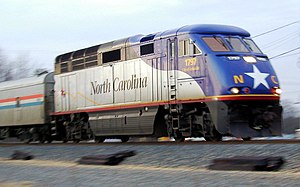EMD F59PH
The EMD F59PH series of locomotives comprises two variants of locomotives built by EMD, the original F59PH and the newer F59PHI. These modern diesel-electric locomotives are popular among North American commuter rail services.
F59PH
| EMD F59PH | |||||||||||||||||
|---|---|---|---|---|---|---|---|---|---|---|---|---|---|---|---|---|---|
 GO Transit at Oakville station | |||||||||||||||||
| |||||||||||||||||
| |||||||||||||||||
| |||||||||||||||||
| |||||||||||||||||
The F59PH was the first in the "F59" Series of locomotives. Eighty-three locomotives were built from May 1988 to May 1994 for two commuter transit railroads, Metrolink of Los Angeles, California, and GO Transit of Toronto, Ontario Canada.
The locomotives featured a 12-cylinder EMD 710 prime mover producing 3,000 hp (2.24 MW), front and rear platforms, a full-width cab with a three-piece windshield. Earlier EMD cowl-type locomotives had used a two-piece windshield, while the Canadian comfort cab used a four-piece design.
The F59PH is still used today, mainly on commuter railroads. The railroads that own and operate F59PH locomotives as of Jan 1st, 2010 are:
- GO Transit, Toronto, Ontario
- Metrolink, Los Angeles, California
- NCDOT, North Carolina on Piedmont (acquired secondhand from GO Transit)
- Trinity Railway Express, Dallas-Fort Worth, Texas (acquired secondhand from GO Transit)
- Agence métropolitaine de transport, Montreal, QC. (acquired secondhand from GO Transit through CAD (Canadian Allied Diesel), Lachine, QC)
- Via Rail Canada (on lease from CAD (Canadian Allied Diesel), Lachine, QC, to replace EMD F40PH-2's currently being rebuilt)
-
Metrolink F59PH 860 in Irvine Station, Southern California with old Bombardier cars. Photo by Brian Zimmerman.
F59PHI
| EMD F59PHI | |||||||||||||||
|---|---|---|---|---|---|---|---|---|---|---|---|---|---|---|---|
 | |||||||||||||||
| |||||||||||||||
| |||||||||||||||
| |||||||||||||||
| |||||||||||||||

The Electro-Motive Diesels F59PHI diesel-electric locomotive is a common locomotive on passenger trains in North America, built by General Motors Electro-Motive Division.
First built in 1994, the locomotive is a 3,200 hp (2.4 MW) B-B diesel-electric locomotive intended for service on North American mainlines. This locomotive is equipped with a turbocharged EMD 12-710E3,a 12 cylinder, 2 stroke water cooled "Vee" diesel engine (prime mover). The main (traction) alternator converts mechanical energy from the prime mover into electrical energy that is distributed through a high voltage cabinet and rectifier to direct current traction motors. Each of the four traction motors is directly geared to a pair of driving wheels. The gear ratio of the traction motors (model D87BTR) to wheel axle determines the maximum operating speed of the locomotive; a standard F59PHI has a gear ratio of 56:21 which provides a top speed of 110 mph (176 km/h).
The F59PHI has a fully enclosed carbody which provides protected walkways for easy access to the engine room and trailing units. This arrangement allows routine maintenance while the locomotive is in service. The noteworthy aspect of this locomotive's exterior is the use of composites to present a streamlined appearance.
To supply electrical power for passenger service, the F59PHI is equipped with a secondary electrical generator referred to as the Head End Power (HEP) unit. The head-end generator generates AC power at 480 V AC, 750 amps or about 500 kW to provide power to the passenger carriages for lighting, electric heating, and air conditioning. The head-end generator is powered by a second diesel engine dedicated to it. With this arrangement, the prime mover is not burdened by head-end power generation and consequently is used solely for supplying tractive efforts.
Examples of the F59PHI are currently operated by these companies:
- AMT (Montreal)
- Amtrak Cascades
- Amtrak California
- Metrolink (Southern California)
- North Carolina Department of Transportation
- North County Transit District (with the San Diego Coaster)
- Sound Transit
- Trinity Railway Express
- West Coast Express
See also
References
- Marre, Louis A.; Withers, Paul K. (2000). The Contemporary Diesel Spotter’s Guide. Halifax, Pennsylvania: Withers Publishing. pp. 112–114. ISBN 1-881411-25-7. LCCN 99-0 – 0.



